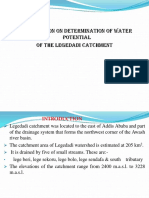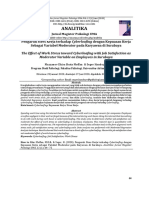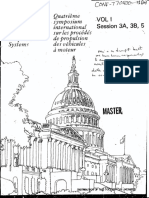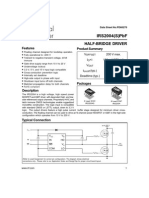0 ratings0% found this document useful (0 votes)
184 viewsBasic Dfwmac
Basic Dfwmac
Uploaded by
Dinesh Kumar PThe document summarizes the basic access mechanism of IEEE 802.11, known as carrier sense multiple access with collision avoidance (CSMA/CA). It describes how nodes use random backoff times and carrier sensing to access the shared medium in a distributed manner to avoid collisions. It also discusses two optional extensions: RTS/CTS to deal with the hidden terminal problem, and fragmentation to reduce frame error rates by using shorter frames. Finally, it introduces polling-based point coordination function (PCF) which uses a polling access point to provide time-bounded services.
Copyright:
© All Rights Reserved
Available Formats
Download as DOC, PDF, TXT or read online from Scribd
Basic Dfwmac
Basic Dfwmac
Uploaded by
Dinesh Kumar P0 ratings0% found this document useful (0 votes)
184 views6 pagesThe document summarizes the basic access mechanism of IEEE 802.11, known as carrier sense multiple access with collision avoidance (CSMA/CA). It describes how nodes use random backoff times and carrier sensing to access the shared medium in a distributed manner to avoid collisions. It also discusses two optional extensions: RTS/CTS to deal with the hidden terminal problem, and fragmentation to reduce frame error rates by using shorter frames. Finally, it introduces polling-based point coordination function (PCF) which uses a polling access point to provide time-bounded services.
Original Description:
DFWMAC
Copyright
© © All Rights Reserved
Available Formats
DOC, PDF, TXT or read online from Scribd
Share this document
Did you find this document useful?
Is this content inappropriate?
The document summarizes the basic access mechanism of IEEE 802.11, known as carrier sense multiple access with collision avoidance (CSMA/CA). It describes how nodes use random backoff times and carrier sensing to access the shared medium in a distributed manner to avoid collisions. It also discusses two optional extensions: RTS/CTS to deal with the hidden terminal problem, and fragmentation to reduce frame error rates by using shorter frames. Finally, it introduces polling-based point coordination function (PCF) which uses a polling access point to provide time-bounded services.
Copyright:
© All Rights Reserved
Available Formats
Download as DOC, PDF, TXT or read online from Scribd
Download as doc, pdf, or txt
0 ratings0% found this document useful (0 votes)
184 views6 pagesBasic Dfwmac
Basic Dfwmac
Uploaded by
Dinesh Kumar PThe document summarizes the basic access mechanism of IEEE 802.11, known as carrier sense multiple access with collision avoidance (CSMA/CA). It describes how nodes use random backoff times and carrier sensing to access the shared medium in a distributed manner to avoid collisions. It also discusses two optional extensions: RTS/CTS to deal with the hidden terminal problem, and fragmentation to reduce frame error rates by using shorter frames. Finally, it introduces polling-based point coordination function (PCF) which uses a polling access point to provide time-bounded services.
Copyright:
© All Rights Reserved
Available Formats
Download as DOC, PDF, TXT or read online from Scribd
Download as doc, pdf, or txt
You are on page 1of 6
Basic DFWMAC-DCF using CSMA/CA:
The mandatory access mechanism of IEEE 802.11 is based
on carrier sense multiple access with collision avoidance
(CSMA/CA) !hich is a random access scheme !ith carrier
sense and co""ision a#oidance thro$%h random bac&off.
If the medi$m is id"e for at "east the d$ration of 'I(S (!ith
the he") of the CCA si%na" of the )hysica" "ayer) a node can
access the medi$m at once.
If the medi$m is b$sy nodes ha#e to !ait for the d$ration of
'I(S enterin% a contention )hase after!ards.
Each node no! chooses a random baco!! time !ithin a
contention window and de"ays medi$m access for this
random amo$nt of time.
The node contin$es to sense the medi$m.
As soon as a node senses the channe" is b$sy it has "ost this
cyc"e and has to !ait for the ne*t chance i.e. $nti" the
medi$m is id"e a%ain for at "east 'I(S.
+$t if the randomi,ed additiona" !aitin% time for a node is
o#er and the medi$m is sti"" id"e the node can access the
medi$m immediate"y
1
The contention !indo! starts !ith a si,e of e.%. C-min .
/.
Each time a co""ision occ$rs indicatin% a hi%her "oad on the
medi$m the contention !indo! do$b"es $) to a ma*im$m
of e.%. C-ma* . 200 (the !indo! can ta&e on the #a"$es
/ 10 11 21 12/ and 200).
The "ar%er the contention !indo! is the %reater is the
reso"$tion )o!er of the randomi,ed scheme.
-hi"e this )rocess describes the com)"ete access mechanism
for broadcast frames an additiona" feat$re is )ro#ided by
the standard for $nicast data transfer.
'ia%ram sho!s a sender accessin% the medi$m and sendin%
its data. +$t no! the recei#er ans!ers direct"y !ith an
acnowledgement "AC#$.
2
DFWMAC-DCF with %&S/C&S e'tension:
3idden termina" )rob"em occ$rs if one station can recei#e
t!o others b$t those stations cannot recei#e each other.
The t!o stations may sense the channe" is id"e send a frame
and ca$se a co""ision at the recei#er in the midd"e.
To dea" !ith this )rob"em the standard defines an additiona"
mechanism $sin% t!o contro" )ac&ets 4TS and CTS.
The $se of the mechanism is o)tiona"5 ho!e#er e#ery
802.11 node has to im)"ement the f$nctions to react )ro)er"y
$)on rece)tion of 4TS/CTS contro" )ac&ets.
After !aitin% for 'I(S ()"$s a random bac&off time if the
medi$m !as b$sy) the sender can iss$e a re(uest to send
"%&S$ contro" )ac&et.
The 4TS )ac&et inc"$des the recei#er of the data
transmission to come and the d$ration of the !ho"e data
transmission.
3
E#ery node recei#in% this 4TS no! has to set its net
allocation vector ")A*$ in accordance !ith the d$ration
fie"d.
If the recei#er of the data transmission recei#es the 4TS it
ans!ers !ith a clear to send "C&S$ messa%e after !aitin%
for SI(S.
This CTS )ac&et contains the d$ration fie"d a%ain and a""
stations recei#in% this )ac&et from the recei#er of the
intended data transmission ha#e to ad6$st their 7A8.
9ne !ay to decrease the error )robabi"ity of frames is to $se
shorter frames.
In this case the bit error rate is the same b$t no! on"y short
frames are destroyed and the frame error rate decreases.
The IEEE 802.11 standard s)ecifies a !ragmentation mode
4
DFWMAC-+CF with polling:
The t!o access mechanisms )resented so far cannot
%$arantee a ma*im$m access de"ay or minim$m
transmission band!idth.
To )ro#ide a time:bo$nded ser#ice the standard s)ecifies a
point coordination !unction "+CF$ on to) of the standard
'C( mechanisms.
;sin% <C( re=$ires an access )oint that contro"s medi$m
access and )o""s the sin%"e nodes.
The point co-ordinator in the access )oint s)"its the access
time into s$)er frame )eriods
A super !rame com)rises a contention !ree period and a
contention period.
5
6
You might also like
- Price List (India) - L597321A-en - GBDocument232 pagesPrice List (India) - L597321A-en - GBhirpraash01No ratings yet
- Extra WEAR SolutionsDocument7 pagesExtra WEAR SolutionsGiannis MamalakisNo ratings yet
- Nautical Calculations (Gyro Error Calculation)Document10 pagesNautical Calculations (Gyro Error Calculation)Alden Almaquer Delizo83% (24)
- Erudite Mkiv ManualDocument34 pagesErudite Mkiv Manualaqib2012No ratings yet
- Homework #1 (Due On 1/31/2018) : QuartzDocument4 pagesHomework #1 (Due On 1/31/2018) : QuartzIyer VishnuvardhanNo ratings yet
- CIV3506 2022 Assign2 Exemplary2Document33 pagesCIV3506 2022 Assign2 Exemplary2Neil WayneNo ratings yet
- Lecture 6 PPT FinalDocument27 pagesLecture 6 PPT Finalhamza100% (1)
- Assignment ELE8331 Submit by 4 August, 2021: Consider Fig. Q1Gen Shows ADocument8 pagesAssignment ELE8331 Submit by 4 August, 2021: Consider Fig. Q1Gen Shows Aumarsabo100% (1)
- 111 Sample ChapterDocument10 pages111 Sample ChapterAnonymous bfbxnOawNo ratings yet
- GPS ApplicationsDocument26 pagesGPS ApplicationskrrishNo ratings yet
- Tampa Electric Company An Investor Owned Electric Utility Serving Approximately 2 000Document2 pagesTampa Electric Company An Investor Owned Electric Utility Serving Approximately 2 000Taimur Technologist100% (1)
- Review Paper On Future Distribution Feeder Protection Using Directional Overcurrent ElementsDocument8 pagesReview Paper On Future Distribution Feeder Protection Using Directional Overcurrent ElementsIJRASETPublicationsNo ratings yet
- EDC - Important ProblemsDocument12 pagesEDC - Important ProblemssansureNo ratings yet
- Frequency of Free Damped Vibrations (Viscous Damping)Document8 pagesFrequency of Free Damped Vibrations (Viscous Damping)ذوالفقار علي حسينNo ratings yet
- Step4success (Utu Previous Year Question Papers) : Fluid Mechanics Sem IiiDocument6 pagesStep4success (Utu Previous Year Question Papers) : Fluid Mechanics Sem Iiistuart ashrafNo ratings yet
- A Review Paper of Automatic Canal Gate Control of 3-° Induction Motor With PLC and VFD, Powered by Solar System and Monitoring by SCADADocument8 pagesA Review Paper of Automatic Canal Gate Control of 3-° Induction Motor With PLC and VFD, Powered by Solar System and Monitoring by SCADAAbhay SehgalNo ratings yet
- Introductory Notes and Fluid PropertiesDocument51 pagesIntroductory Notes and Fluid PropertiesNitin GuptaNo ratings yet
- FINAL Irrigation and Environmental Drawing - v1 PDFDocument91 pagesFINAL Irrigation and Environmental Drawing - v1 PDFB.ShyamalaNo ratings yet
- Initial Value ProblemsDocument4 pagesInitial Value ProblemsJoseph QuarcooNo ratings yet
- Mobile Communication LabDocument14 pagesMobile Communication Labsoumen maityNo ratings yet
- Summary of MATLAB OnrampDocument3 pagesSummary of MATLAB Onramppriyadarshini0% (1)
- Hydrology: Introduction To The Subject Lecture No. 1Document98 pagesHydrology: Introduction To The Subject Lecture No. 1jp gutierrezNo ratings yet
- Multiple Choice Test Trapezoidal Rule: DX XeDocument2 pagesMultiple Choice Test Trapezoidal Rule: DX XeNikunj PatelNo ratings yet
- Chapter No-02-GT2Document5 pagesChapter No-02-GT2VikasPatilVickyNo ratings yet
- 8 Queens Problem Using Back TrackingDocument3 pages8 Queens Problem Using Back TrackingkathirdcnNo ratings yet
- 188 Sample ChapterDocument14 pages188 Sample ChapterSIDDHANT KATARIANo ratings yet
- Pandoh Baggi TunnelDocument7 pagesPandoh Baggi TunnelMin Chan MoonNo ratings yet
- "Literature Review For Mechanistic Analysis of Rigid PavementDocument8 pages"Literature Review For Mechanistic Analysis of Rigid PavementShalini YadavNo ratings yet
- Assignment No 2 OOPDocument6 pagesAssignment No 2 OOPMoon Mughal100% (1)
- P61-Pile Integrity TesterDocument23 pagesP61-Pile Integrity TesterŽarko LazićNo ratings yet
- 1.exploration With CAS-I.Lab1Document19 pages1.exploration With CAS-I.Lab1Yash KumarNo ratings yet
- Solution of GPSC A.En. Exam Held On 23.06.19Document27 pagesSolution of GPSC A.En. Exam Held On 23.06.19Bharat MahajanNo ratings yet
- Vlsi 2-Marks With AnswerDocument23 pagesVlsi 2-Marks With Answerk poornimaNo ratings yet
- Estimating & Costing - C5 PDFDocument18 pagesEstimating & Costing - C5 PDFkumarNo ratings yet
- Case Study 4Document2 pagesCase Study 4Chirry OoNo ratings yet
- ICT Lab ManualDocument60 pagesICT Lab ManualAiza HabibNo ratings yet
- 1 Vibration Analysis Using MATLABDocument24 pages1 Vibration Analysis Using MATLABShannon Chen TanNo ratings yet
- Test 1 - Sept16 AnswerDocument5 pagesTest 1 - Sept16 AnswerFarah IzzatiNo ratings yet
- A Seminar Report On Vlsi FloorplanningDocument17 pagesA Seminar Report On Vlsi FloorplanningPARAG100% (1)
- New Format Minor ProjectDocument6 pagesNew Format Minor ProjectAditi ShrivastavaNo ratings yet
- Question Paper Code:: Reg. No.Document3 pagesQuestion Paper Code:: Reg. No.Div DeepakNo ratings yet
- Pps Unit Wise QuestionsDocument20 pagesPps Unit Wise QuestionsSHREE GANESHNo ratings yet
- VHDL Code For Full Subtractor Using Behavioral Method - Full Code & ExplanationDocument8 pagesVHDL Code For Full Subtractor Using Behavioral Method - Full Code & Explanationtojo zoNo ratings yet
- Hydraulics EnggDocument131 pagesHydraulics EnggSajid Nazir100% (1)
- 37th Road Plaza Presentation FinalDocument30 pages37th Road Plaza Presentation FinalQueens PostNo ratings yet
- Presentation On Determination of Water Potential of The Legedadi CatchmentDocument25 pagesPresentation On Determination of Water Potential of The Legedadi Catchmentashe zinabNo ratings yet
- Schedule of Rates - 2011-12Document170 pagesSchedule of Rates - 2011-12Raja SekharNo ratings yet
- Standard Method For Gradually Varied FlowDocument5 pagesStandard Method For Gradually Varied Flowj0bgimhanNo ratings yet
- Design of Transmission Systems Question BankDocument27 pagesDesign of Transmission Systems Question BankbalajimetturNo ratings yet
- Re Aastu PP 2Document46 pagesRe Aastu PP 2ellocster21No ratings yet
- OWS Integration Into Manual SystemDocument10 pagesOWS Integration Into Manual SystemOmaya TariqNo ratings yet
- CMOS Process FlowDocument35 pagesCMOS Process Flowag21937570No ratings yet
- Bit StuffingDocument3 pagesBit StuffingSaurav PooniaNo ratings yet
- Design of Vertical Drop Fall: Surface FlowDocument3 pagesDesign of Vertical Drop Fall: Surface FlowMohammed100% (1)
- Sor 2010Document411 pagesSor 2010Neeraj AgrawalNo ratings yet
- Iot LevelsDocument8 pagesIot LevelsSanthiya RNo ratings yet
- Ansys Practice Problem#1Document6 pagesAnsys Practice Problem#1JOHN ROHAAN R 1961430No ratings yet
- GSM Principles and Call FlowDocument263 pagesGSM Principles and Call FlowTOMTOB_123No ratings yet
- Lab Viva C&NDocument8 pagesLab Viva C&NWesley Moses SamdossNo ratings yet
- CS 610 Solved MCQS Mega FileDocument50 pagesCS 610 Solved MCQS Mega Filecool_eyez56% (9)
- Unit Ii - Congestion and Traffic Management Part - ADocument7 pagesUnit Ii - Congestion and Traffic Management Part - Aselvakrishnan_sNo ratings yet
- WAN TECHNOLOGY FRAME-RELAY: An Expert's Handbook of Navigating Frame Relay NetworksFrom EverandWAN TECHNOLOGY FRAME-RELAY: An Expert's Handbook of Navigating Frame Relay NetworksNo ratings yet
- Software Engineering SyllabusDocument2 pagesSoftware Engineering SyllabusDinesh Kumar PNo ratings yet
- Int 3 MTDocument1 pageInt 3 MTDinesh Kumar PNo ratings yet
- Important Questions in AIDocument2 pagesImportant Questions in AIDinesh Kumar PNo ratings yet
- FDDI (Fibre Distributed Data Interface)Document3 pagesFDDI (Fibre Distributed Data Interface)Dinesh Kumar PNo ratings yet
- C PgmsDocument8 pagesC PgmsDinesh Kumar PNo ratings yet
- DSL & CategoriesDocument7 pagesDSL & CategoriesDinesh Kumar PNo ratings yet
- Slip & PPP ProtocolDocument9 pagesSlip & PPP ProtocolDinesh Kumar PNo ratings yet
- First Order Logic: More Expressive Than Propositional LogicDocument2 pagesFirst Order Logic: More Expressive Than Propositional LogicDinesh Kumar PNo ratings yet
- Pointers in CDocument7 pagesPointers in CDinesh Kumar PNo ratings yet
- Cellular Wireless NetworksDocument5 pagesCellular Wireless NetworksDinesh Kumar PNo ratings yet
- Experiment Details - AlgorithmDocument2 pagesExperiment Details - AlgorithmDinesh Kumar PNo ratings yet
- DNS - Domain Name Server - UDP - Networks & DBMS Lab - C ProgramDocument3 pagesDNS - Domain Name Server - UDP - Networks & DBMS Lab - C ProgramDinesh Kumar PNo ratings yet
- Cdma: Code Division Multiple Access (CDMA) Systems UseDocument5 pagesCdma: Code Division Multiple Access (CDMA) Systems UseDinesh Kumar PNo ratings yet
- Users Guide: API Version 2.7Document44 pagesUsers Guide: API Version 2.7Danilo AraújoNo ratings yet
- Pengaruh Stres Kerja Terhadap Cyberloafing Dengan Kepuasan KerjaDocument9 pagesPengaruh Stres Kerja Terhadap Cyberloafing Dengan Kepuasan KerjaWulandari Rima KumariNo ratings yet
- Ref 8Document4 pagesRef 8ТNo ratings yet
- ETABS 18.0.2-Report ViewerDocument10 pagesETABS 18.0.2-Report ViewerFady MagdyNo ratings yet
- Using Regression Analysis To Estimate Water Quality Constituents in Bahr El Baqar DrainDocument11 pagesUsing Regression Analysis To Estimate Water Quality Constituents in Bahr El Baqar DrainDale LacastreNo ratings yet
- Quantum Mechanics 5th Edition Alastair I M Rae: Supporting MaterialDocument17 pagesQuantum Mechanics 5th Edition Alastair I M Rae: Supporting MaterialAlma MoralesNo ratings yet
- AGEC 251-ElasticityDocument45 pagesAGEC 251-ElasticityJoshua Annan. K. OkyereNo ratings yet
- Semester Viii: Total Quality ManagementDocument4 pagesSemester Viii: Total Quality ManagementNano GowthamNo ratings yet
- Alamouti 2x3Document4 pagesAlamouti 2x3Bharghava Sasanka DesuNo ratings yet
- Module 4 - Alcohol, Ether and AldehydeDocument62 pagesModule 4 - Alcohol, Ether and AldehydePrincess NavarroNo ratings yet
- On-Line Determination of Cation Conductivity in High Purity WaterDocument5 pagesOn-Line Determination of Cation Conductivity in High Purity WaterAamir NaweedNo ratings yet
- MasterDocument525 pagesMasterؤآللهہ حہبہيہتہكہNo ratings yet
- Lauro Vals Venezolano 3 NataliaDocument4 pagesLauro Vals Venezolano 3 NataliaMarcelo FigueroaNo ratings yet
- Cbse Art Integrated ProjectDocument9 pagesCbse Art Integrated ProjectSridip BasuNo ratings yet
- SMK 630 DDocument8 pagesSMK 630 DMuhammad Chaidir FhadlyNo ratings yet
- Instruction Manual: Model#: 119203C LIT #: 98-1164/03-10Document12 pagesInstruction Manual: Model#: 119203C LIT #: 98-1164/03-10david churaNo ratings yet
- An Introduction To Infrared and UV-Visible SpectrosDocument45 pagesAn Introduction To Infrared and UV-Visible SpectrosYasir AlamNo ratings yet
- Cummins EngineDocument86 pagesCummins Enginecarlos morales100% (2)
- Irs2004 (S) PBF: Half-Bridge DriverDocument15 pagesIrs2004 (S) PBF: Half-Bridge DriverDragoslav RadoičićNo ratings yet
- Tubing and Casing Thread Inspection 2014Document44 pagesTubing and Casing Thread Inspection 2014xmacaba100% (4)
- Tests SwitchesDocument31 pagesTests Switchesmrtabiehj100% (1)
- Pages From Combustion Driven OscillationsDocument1 pagePages From Combustion Driven OscillationsWrya SaeedNo ratings yet
- Advanced Design of GlassDocument47 pagesAdvanced Design of GlassPaloma ValeNo ratings yet
- Os and CN LabDocument70 pagesOs and CN Lab18-5N7 Chetan reddyNo ratings yet
- ClassimatDocument11 pagesClassimatRonak JoshiNo ratings yet
- B Techr2015Document188 pagesB Techr2015End Semester Theory Exams SathyabamaNo ratings yet
- Advanced Networking: Course Objectives Course DescriptionDocument1 pageAdvanced Networking: Course Objectives Course DescriptionTame PcAddictNo ratings yet
- Lecture 02Document81 pagesLecture 02BenNo ratings yet






































































































